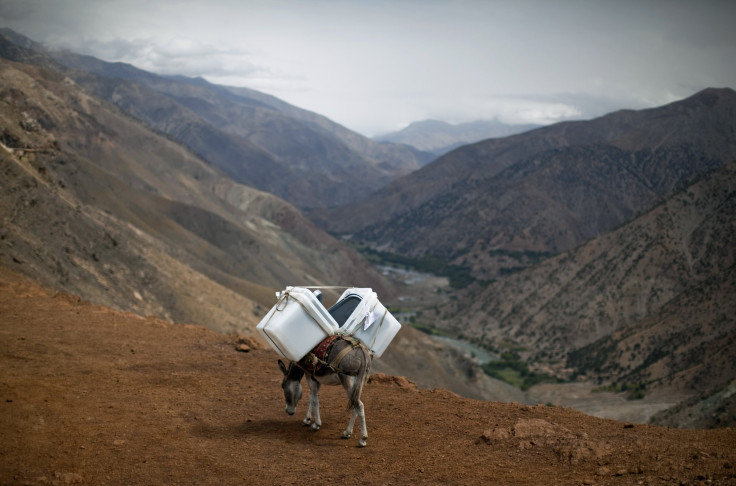Drones For Development: How 'Flying Donkeys' Could Revolutionize African Economies

ADDIS ABABA, Ethiopia – If donkeys could fly, life would be a whole lot easier for residents of developing countries.
In rural communities where roads are scarce or in disrepair, moving commodities from one place to another can be an arduous process. Donkeys have become indispensable in many places where vehicles are impractical or prohibitively expensive, but the animals have limits in terms of speed and distance. The problem is a constant challenge for small-scale farmers in remote communities, and is especially dire during times of crisis when people need medical supplies or humanitarian aid.
But what if commercial goods and life-saving supplies could travel quickly and cheaply, regardless of conditions on the ground? That's the idea behind the Flying Donkey Challenge, a global technology contest that hopes to revolutionize the transportation of goods.
The project aims to create a commercially viable cargo robot – an unmanned aerial vehicle rugged enough to carry medium-sized loads over long distances – by 2020. The challenge is in its early stages; teams from around the world are currently signing up and getting started on new ideas. The eventual winners will design and build a machine capable of carrying upward of 20 kilograms (44 pounds) over a distance of 50 kilometers (31 miles) in under an hour. Before 2020, competing teams will test their prototype in a 24-hour race around Mount Kenya, Africa's second-highest peak. The victors will win a cash prize worth millions.
Africa, home to some of the poorest countries on earth, is a special focal point for this global challenge, which is why project leaders are keen to get African technology experts involved early on. On a trip to a technology institute in Ethiopia's capital city of Addis Ababa, Project Director Jonathan Ledgard urged students to use their own design sensibilities to come up with novel ideas.
Students across the continent have had mixed responses to the challenge.“Some people say it's amazing and are really excited to do it, but on the other extreme is pessimism and wondering how this technology could work here,” Ledgard told IBTimes. “And there is another element: lack of confidence. They say, 'We can't do it, because we've never done anything like this before.' But I think we're heading into a different period, and I really believe very strongly in the ability of young Africans to invent and create very sophisticated technologies.”
African students and tech professionals are encouraged to team up with Western technology experts for the challenge, and the collaborations should bring developing-world design sensibilities to bear on the latest advances from places like the Massachusetts Institute of Technology, the California Institute of Technology and Imperial College London.
The Flying Donkey Challenge is based in Switzerland as an initiative of the École Polytechnique Fédérale de Lausanne and the Swiss National Centre of Competence for Research in Robotics. It could cost about $10 million – much of which will be used to entice the greatest minds on earth to devote time and laboratory space to the endeavor – and will be supported by La Fondation Bundi, a nonprofit fund held by the Lombard-Odier Bank in Geneva.
The project comes at an interesting time. Unmanned aerial vehicles are most often associated with military operations, most notably the legalistically hazy program of strikes and surveillance carried out by Western powers against suspected terrorists. But new applications for aerial robots are emerging and capturing imaginations, as illustrated by the futuristic delivery concept announced by Amazon (NASDAQ:AMZN) in December. Called Prime Air, it will use drones to deliver packages in under an hour. The company plans to roll out the technology by 2015.
Ledgard hopes the Flying Donkey Challenge will result in a viable model before its tentative 2020 deadline, and that the airborne machines could become a common sight in African skies as soon as 2025. Making the product commercially viable might be a long process – early demand would be likely to come not from rural communities, but from organizations with more resources to spend and more goods to transport. “In the first phase you'll probably have [demand from] a lot of governments, tourism operations and NGOs.” he said. “Right now in South Sudan, they have a desperate need to fly supplies around the country. If I were in the Red Cross I'd be using Flying Donkeys all around South Sudan for things like vaccines, medicines, batteries or vehicle spare parts.”
As the Flying Donkey matures and production costs decrease, it could become a viable tool for farmers, merchants and consumers in remote areas. The idea is to make a machine that is compatible with the demands of African livelihoods, rather than something adopted from a Western model.
“What I'm completely sure about is that this technology is inevitable; it's going to happen all around the world,” Ledgard said. “The only question is whether it will be developed here in Africa, by Africans, in a way that is useful for African economies.”
© Copyright IBTimes 2024. All rights reserved.






















